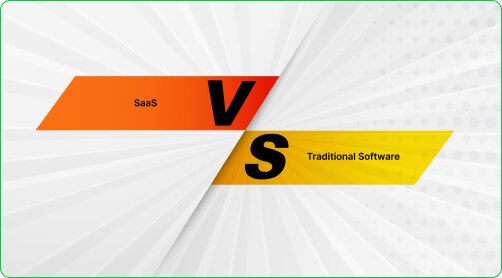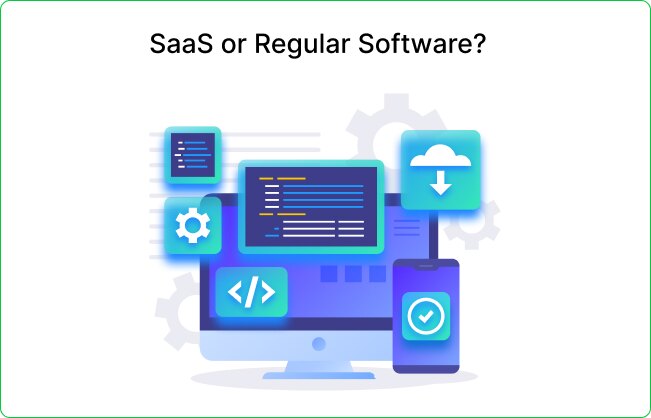 SAAS
SAAS

25 January, 2024

When your organization is considering acquiring new software, regular software applications vs SaaS applications become an important topic to discuss. You need to know about their cost analysis, scalability, data security options, and some other must-consider factors.
So, what distinguishes a SaaS platform from regular software applications?
There are many aspects from where the answer comes. Keep reading to learn about every point that draws a line between SaaS and a regular software application. We will also answer some frequently asked questions so you leave the webpage with zero confusion.
Deal done? Let’s get started!
Contents
We’d like to start the discussion with a live example of a regular software application- Adobe Photoshop. To work with Adobe Photoshop, you need to install it on your computer and run it locally.
Similarly, PowerPoint and MS Office are two examples of regular software aka desktop software. You need to install it first and the updates, security, and maintenance are your responsibility.
Initially, this fact builds a wall between a regular software application and SaaS. SaaS doesn’t require installation, you can easily access SaaS applications using a web browser. Also, the updates and maintenance are not your headache when you’re using SaaS applications.
These are the surface-level discussions about regular or traditional software applications. Let’s move on to SaaS topics now.
According to statistical data from grandviewresearch, the market size for Software as a Service (SaaS) in 2023 was USD 333.03 billion. This represents the total value of the SaaS market at that specific point in time. By 2030, the SaaS market is expected to be significantly larger than its initial value.
Now, coming to the point of ‘what does SaaS mean?
The term ‘SaaS’ is an abbreviation of ‘Software As A Service’. Since SaaS is hosted in a cloud-based address, there’s no need for a physical installation in this case.
For this, operating SaaS is a more straightforward process. Hence, you don’t have to worry about a high amount of upfront payment like a regular software application. Instead, you just get the service from the provider in exchange for a monthly subscription fee.
In short, you BUY and install the complete platform when you work with a regular software application. But when it’s SaaS, you just RENT it and pay a subscription fee. There are SaaS tools that offer free plans that are a nice way to get started.
| Parameters | SaaS (Software as a Service) | Regular Software Application |
| Architecture | Multi-tenant architecture shared infrastructure among multiple users/organizations. | Single-tenant architecture, dedicated infrastructure for each user/organization. |
| Deployment | Web-based deployment, accessible through a browser. It eliminates the need for local installations. | Requires local installation on individual machines or servers. |
| Customization | Limited customization options. | Greater flexibility for customization to meet specific user or organizational needs. |
| Updates and Maintenance | Centralized updates allow all users to have access to the latest features and security patches simultaneously. | Users need to manually update software, and maintenance is typically decentralized. |
| Scalability | Easily scalable as resources are shared among tenants, accommodating varying user loads. | Scalability may require additional infrastructure and resources for each instance. |
| Cost Model | Typically subscription-based, with users paying for the services they use regularly. | Often involves a one-time license fee or periodic payments for software usage. |

By now, you already know the surface-level talks about SaaS and a regular software application. This time, we will have a more detailed discussion about the topic.
SaaS works on a multi-tenant architecture. Which means, every user shares the same application and database. But do the users access others’ databases? No, their data is isolated to prevent public access.
The multi-tenant architecture allows for efficient resource usage and scalability since the same software serves multiple users.
On the contrary, a regular software application works on a single-tenant architecture so every user has a different hardware, OS (Operating System), DBMS (Database Management System), and server.
This setup offers a separate and exclusive environment for every user.
SaaS applications are not flexible enough. They’re limited to the services offered by the SaaS companies. For example, you can’t watch any show on Netflix because Netflix is a SaaS. You can only enjoy shows that are on Netflix.
But in regular software applications, regular software applications own the data which offers an upper hand in customizability. These applications can easily customize the software according to their needs.
Think about µTorrent Classic. It’s a desktop-based software application that lets you download almost any show. You hardly experience the limitations of Netflix here.
So, when it comes to regular software applications, businesses can modify the software to fit their specific needs such as user interface, adapting features, and workflows. However, users are generally limited to the features and customization options provided by the SaaS platforms.
You don’t own the software when using a SaaS platform. You just have a pay-as-you-go relationship with the software application. Since you don’t own the software, you don’t own the data stored in it.
This can be a concern for small and medium-sized enterprises (SMEs) because of the potential risks of data breaches. If the provider is compromised, there’s a chance of breaching sensitive data through unauthorized parties.
On the flip side, you own the software license of a regular software application. So, you have direct control over the data generated or stored by the application. In this case, you don’t have to rely on external parties for data management and security. It makes this application more secure.
The scalability of SaaS applications is higher. As an SME grows and requires more user access, scaling up is easy with a simple change in the subscription plan. There’s no need to purchase individual licenses. This can save SMEs money.
However, the case is different in regular software applications. For SMEs, as their business grows, they need more people to access the software. It means they must purchase additional licenses as a result.
This can become expensive over time when the business expands.
No platform is 100% secure when it comes to cyber threats. However, SaaS applications pose a higher risk of data leaking. Why?
Well, we already explained in the ‘data ownership’ section that you don’t own the stored data of a SaaS application. The data is stored on the provider’s servers. This fact can raise questions about the security and privacy of the data.
Unlike SaaS, regular software applications offer more security.
However, there’s a slight risk in regular software applications as well. If we think from another angle, both SaaS and regular software applications possess some risks.
The structure of regular software applications’ DBMS, OS, and server is not complicated. This is why hackers can easily access and breach the data if they manage to compromise the server.
Speaking of hacking, SaaS is also not free from risk. Since SaaS works in multi-tenant architectures, the shared environment can also be at risk of breaches.
If a hacker breaches the shared infrastructure of a SaaS provider, they can gain access to the data of multiple users simultaneously.
So yes, neither regular software applications nor SaaS models are completely immune to cyber threats.

The answer depends on your preference and acceptance. If we recap what we discussed above, here’s the summary.
SaaS applications offer a wide range of benefits. They are much faster and easier to use, and a much more affordable option. SaaS solutions are highly flexible and you don’t have to give time and effort on the maintenance as it’s the responsibility of the provider.
To work with SaaS platforms, all you need is a laptop or desktop, a good internet connection, and a web browser.
On the contrary, the scalability of a business is easier with a regular software application. Although SaaS is globally well-known, some applications still can restrict the scope. Also, regular software platforms offer better customizability.
The priority for B2B companies lies in regular software, with a focus on ensuring client security, while B2C businesses show a preference for SaaS.
Now, you decide which benefits are more needed for your business and which limitations you can compromise.
The biggest reason why most businesses prefer using a SaaS model is that it offers a lower entry cost. Unlike regular software applications, you don’t need to physically install the platform on your computer and pay a high license fee.
Yes, it is. Since Netflix is a cloud-based service, it requires a subscription fee instead of a purchase of the license, it’s a SaaS business model. Netflix is centrally hosted, so, the users do not have to maintain or update the software. So, yes, Netflix meets all the criteria of SaaS platforms.
SaaS platforms are both Frontend and Backend. The Frontend part involves CSS, Javascript, and HTML. And, the Backend of SaaS platforms involves Servers such as Amazon Web Services, Nginx, and so on.
Thanks for still being with us. We tried our best to clarify what distinguishes a SAAS platform from regular software applications. Hopefully, you’ve already decided the right platform for your business. No matter which platform you choose, just be sure that your chosen one perfectly matches your business needs.
Know more: IaaS vs PaaS vs SaaS: Examples, Differences, Benefits & Case Studies